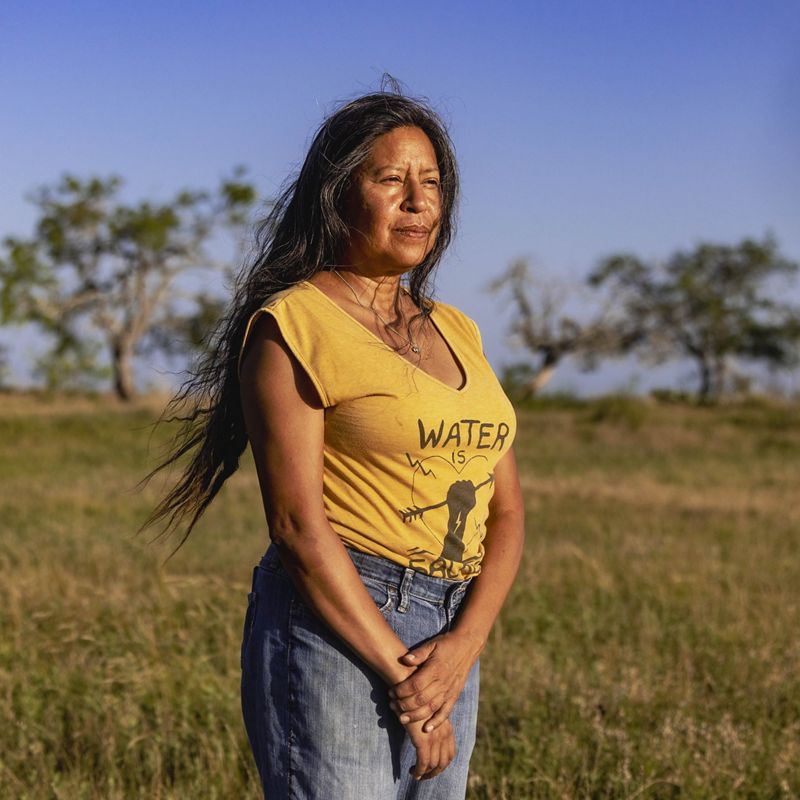
Coming Home
Lucille Contreras set out to reconnect her Lipan Apache community with its heritage. She brought buffalo back to Texas Native American land.
Winter 2022 Issue
Lucille Contreras stepped onto the porch of her white wooden ranch house and blew a tone through a conch shell horn. The two dozen kids camped in her yard finished their breakfast tacos and gathered to listen.
Under shade from the summer Texas sun, Contreras called the children up front and told them about a promise she’d recently made. She’d signed a treaty with other “buffalo nation” tribes at an intertribal gathering in Wyoming just a few days before.
“I’m going to take care of the buffalo for the rest of my life,” she said with measured enunciation. “Just like I’m taking care of you children by inviting you to my land.”
Then she called on two kids to lead a morning song. In the pasture nearby, a small herd of buffalo wandered. It was day three of the first official Lipan Apache summer camp at the Texas Tribal Buffalo Project, a new nonprofit based on a ranch in the rolling prairie of rural south-central Texas.
Contreras, an energetic mother and information technology manager from San Antonio, founded the project in 2020 with visions of creating a place where Native peoples could practice culture and heal. All along, her dream was to bring her community out for days at a time to let the children bond with one another, the land and the buffalo.
“These young people are our focus and priority,” Contreras said, looking out at the kids who had gathered despite the 100-degree heat. “They are seeds, and we are putting in the water and nutrients so they will grow.”
Generations of trauma—genocide, forced relocations, destruction of culture, mockery in old movies, poverty and more—left the Lipan Apache and other Native peoples dissociated and disconnected from the land, Contreras said. Their culture once revolved around the buffalo, but they’d slowly lost that connection along with the buffalo. Now she’s trying to turn things around.
Quote: Laura Yohualtlahuiz Rios-Ramirez
No matter how hard a system tries to erase who we are and tear away our identity, the buffalo are a beautiful reflection of our own resiliency.
This summer camp in June was the first time any of the children had ever seen a buffalo (American bison). It was an unassuming encounter. Fifteen buffalo and about as many kids eyed each other at a distance across the wide sun-drenched pasture, unaware they were making history.
But the parents knew. Laura Yohualtlahuiz Ríos-Ramírez watched her two sons, Huitzi and Ketzal, and she began to cry. A team member at the Buffalo Project, she knew the moment was hard won.
She thought of all the violence—the slaughter of the buffalo and the Native people so much done to prevent either of them from being here. Yet the Lipans engineered this encounter. Their children were meeting the old companions. They were camped on Native-owned land, hosted by a women-led organization, talking about culture.
“It’s a generational dream come true,” Ríos-Ramírez said, wiping away tears under the shade of a live oak tree. “No matter how hard a system tries to erase who we are and tear away our identity, the buffalo are a beautiful reflection of our own resiliency.”
Ríos-Ramírez came from San Antonio, a city founded centuries ago by the mixture of Spanish and Native American peoples. But she had no camps like this growing up. For her, expressions of Native culture were more seasonal, and they revolved around dance. Now the movement has land. And it has buffalo.
The vision for this project started with Contreras in the years she worked with Native American activist communities in states other than Texas. Despite a long connection to the geography, Native Americans were left with only a few tiny reservations in Texas.
After six years of helping to raise buffalo on the Pine Ridge Indian Reservation in South Dakota, she knew what she wanted: a Lipan buffalo ranch in Texas. Caring for the animals would be the easy part. First, she needed money to make it happen.
She leaned into her network of Native activists and mentors, gathering support from organizations like Tanka Fund and Honor the Earth, and learning from a Business of Indian Agriculture curriculum offered by the First Nations Development Institute. She won a USDA loan to buy 77 acres of gently rolling grassland in the tiny town of Waelder, Texas. AmeriCorps Vista funded her eight staff positions.
Contreras purchased three buffalo from a privately owned Texas herd, an anonymous donor delivered a fourth, and The Nature Conservancy transferred five from its Zapata Ranch buffalo herd in Colorado.
For TNC, the transfer was part of a budding effort to move surplus buffalo from managed herds to the custody of Indigenous communities across the country. Since 2020, the organization has transferred about 270 animals to 12 communities, where Native leaders have led the restoration of the once-great North American buffalo herds.
Although these creatures are mostly known today in the Midwest and the Rockies, they used to roam from above the Arctic Circle in Canada to northern Mexico and almost coast to coast, says Corissa Busse, TNC’s Western South Dakota Program director and a co-leader in TNC’s buffalo restoration program. Their absence today in their southern range, including Texas, has to do with the earlier arrival of the railroad and, with it, the campaign of wholesale slaughter in the South, she said.
Historically they were a keystone species whose day-to-day grazing was a fundamental force in prairie ecology. Certain plants only sprouted in their hoofprints. Others were seeded through their dung. Birds nested in their discarded wool and large carnivores subsisted on the herds. Just as the return of buffalo to grasslands can restore a web of living relationships, their return to Native communities can nurture a sharing of culture.
“Buffalo play an irreversible role in the land,” Busse says. “They are a part of place.”
At the Buffalo Project, bison define the place as one of Native healing for both the land and the Native culture tied to it. For the Lipan Apache, who haven’t controlled much land or wealth for centuries, having this space in Waelder has enabled the community to develop.
At the summer camp, many of those gathered had known one another for years. Some parents were old friends from Indigenous Aztec dance troupes or from an earlier era of Lipan organizing. They’d spent time together when they were younger and saw one another a few weekends per year. But until now they had never set up their tents, let their children make friends and, in the serenity of a private place, talked about culture and the Earth. At camp they shot arrows with bows, built fires, caught and filleted fish, learned about ethnobotany, made art, sang songs, shared meals, danced and practiced rituals. But mostly, they were just together.
“These ceremonies open space for intimate conversations,” said Josekuauhtli Maestas, a curriculum and data researcher at the Buffalo Project, who is also Contreras’ son. “I want that in my life.”
This land has also drawn new members to the community. One man, 70-year-old Juan Alejandro, drove two hours from Houston with his 11-year-old grandson, Maximus Amaya, trying to make sense of his own roots.
Alejandro was born near the Mexican border, a frontier where many Indigenous peoples once sought their final refuge from military campaigns against them. His grandmother—though she rarely spoke about her ancestry—told stories about the last hideouts of the Apaches. But her tales of the family’s Indigenous ancestry would sometimes cause upset and tension. It confused Alejandro. Later in life he understood.
“It was taboo to be Indigenous—they would catch you and kill you,” he said.
Alejandro moved 300 miles to Houston when he was 12, and memories of his grandmother faded with childhood. Still, he always wondered. It wasn’t until his mid 60s that he found Texas Apache communities on Facebook, where people told stories like his grandmother’s and described families like his own. When he saw plans online for the summer camp, he took his grandson, Maximus, and drove 115 miles to Waelder.
“I want him to know his ancestry,” Alejandro said.
While Maximus played, Alejandro learned Lipan history and the origins of several Apache words from the elders who lounged together in camp chairs under shade. One of them was Richard Gonzalez, a retired police officer who travels the state presenting Lipan history at schools and events. He can’t count how many times people like Alejandro have approached him, he said, with the same family stories, looking for clarity.
When they do, Gonzalez tells the long story of the Lipan Apache who followed buffalo across Texas and Mexico in numerous independent bands. They fought Spanish settlement but sometimes settled in missions or married into towns. During the Texas Revolution, Lipan Apaches fought alongside Texas rebels in their fight for independence. Over time the populations mixed.
U.S. statehood in Texas brought a renewed effort to remove Native inhabitants amid a flood of new migration. Motley bands of settler lawmen harassed and killed Indigenous peoples wherever they could while the U.S. Army chased others relentlessly.
By the start of the 20th century, some tribes in Texas were deported to reservations out of state. In some cases, the Lipan Apache were written off as extinct. But they weren’t, Gonzalez said. There were Lipans who survived the raids. Gonzalez’ great-grandmother Juanita was one of them.
Survivors like Juanita settled throughout South Texas and beyond. If the law came looking, they blended in, speaking only English and Spanish. For their children they wished only for a life free from violent persecution. Apache stories were dangerous secrets.
For Alejandro, the story brings peace. During his life in South Texas he had been called a Mexican, an outsider, an immigrant. Now he knows that, like the buffalo, he belongs here. And his grandson knows it, too.
“I’m so glad we’ve found home, so to speak,” he said.
The Texas Tribal Buffalo Project, with all its open land, isn’t only for the Lipan Apache. Contreras dreams of making her space for all kinds of marginalized and underserved people who want a deeper connection to open, outdoor spaces. For the camp, she brought four youths as volunteer counselors through a partner organization, Circles in Da Hood, which counsels at-risk youth in San Antonio.
“I’ve always been in a crowded household in the city. I’ve never been out to explore anywhere else,” said one counselor, 19-year-old Karizma Cedillo Williams. “To see the stars and the buffalo and a sunrise over the open land, it’s like a dream.”
For Contreras, this camp marked a major milestone in the growth of her nonprofit and the realization of her dreams. But she insists there is still much more to come. She is working to get donated buffalo for other Lipan communities in Texas. And she’s hoping to source funding to buy additional acreage that would allow her to sustain a larger buffalo herd.
With a larger herd on more land, the Buffalo Project could help provide Indigenous communities access to a traditional food staple and culinary heritage of buffalo-based recipes. Already the Buffalo Project has sold meat to the Cherokee nation.
One thing is certain: There will be many more camps. Contreras already plans for another summer camp in 2023.
“I believe that this is what our ancestors prayed for,” she said, nodding at the adults relaxing while children played and the buffalo grazed. “We’re just all so happy to be here.”
Magazine Stories in Your Inbox
Sign up for the Nature News email and receive conservation stories each month.











